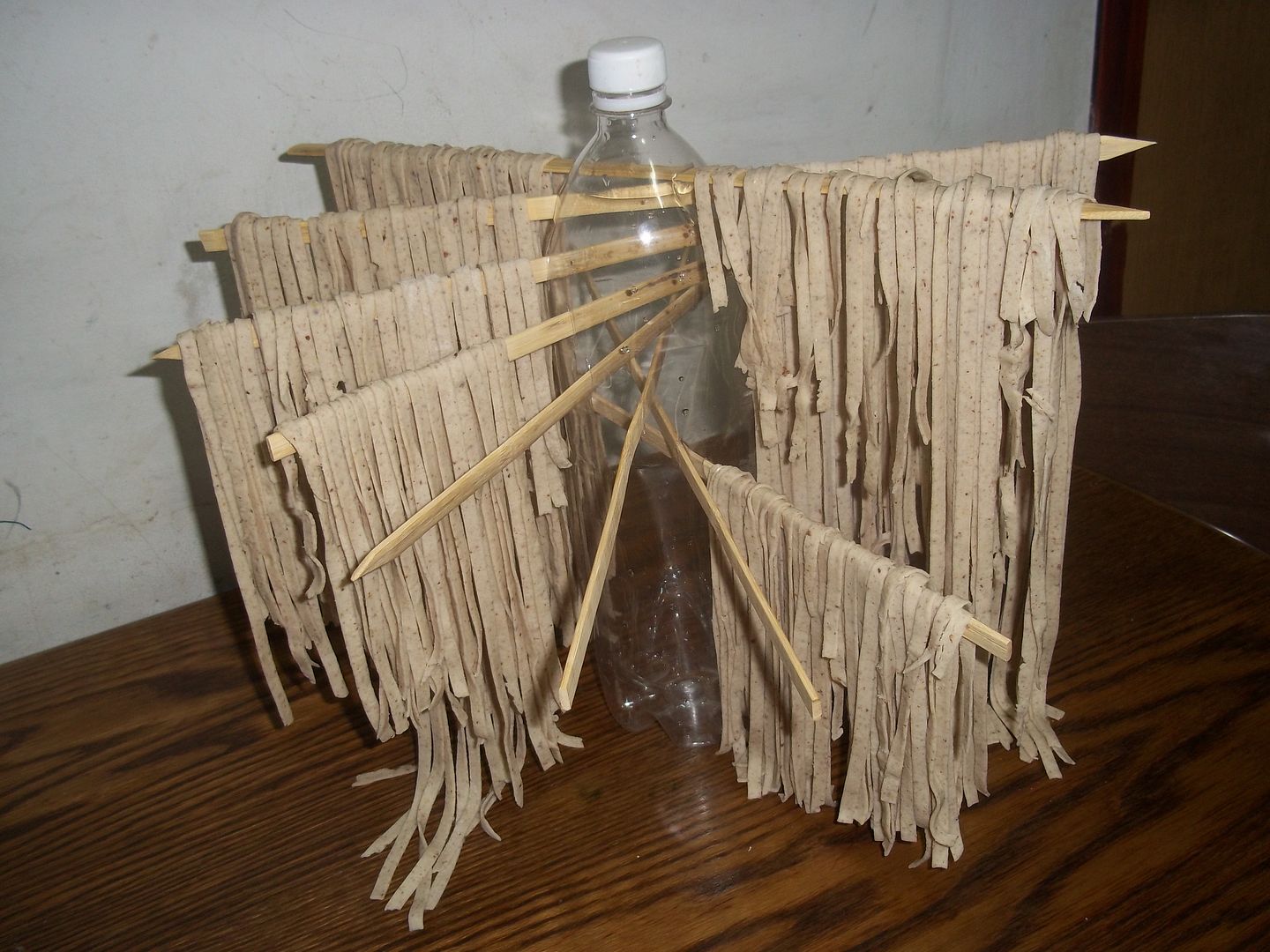 I’ve been making homemade pasta ever since I read you could do it on under1000permonth.blogspot.com with 3 cups whole wheat flour and one cup water. So cheap, pretty easy. And I was able to make whole wheat pasta for cheaper than the store bought white flour pasta.
I’ve been making homemade pasta ever since I read you could do it on under1000permonth.blogspot.com with 3 cups whole wheat flour and one cup water. So cheap, pretty easy. And I was able to make whole wheat pasta for cheaper than the store bought white flour pasta.
When I would make that pasta, I would use a rolling pin to roll it out really well, and then a pizza cutter to cut the pasta to size.
It was very cheap. But it was also a lot of work.
I didn’t switch over to making all my own pasta then, because it was a bit too much work. I mostly did it when I wanted lasagna, because then the exact thickness of the pasta mattered less, and it was less work because it didn’t involve cutting out pieces of pasta and then boiling them… and also when I made ravioli, because it was a fraction of the price of store bought ravioli and my husband loves ravioli so much.
So homemade pasta happened. But much less frequently than using store bought pasta.
And then I went gluten free. And gluten free pasta in the store is pretty expensive, and doesn’t taste so good even. I started making my own pasta at home a little more frequently than I did in the past, because the pay off financially was worth it. But just a little more frequently, because pasta was my back up meal, for when I was in a rush, and making pasta wasn’t so easy, in terms of rolling it out, making sure it was the right thickness, cutting it, etc…
And then I got a pasta maker. It wasn’t an intentional purchase. I had to return something to a store that I didn’t care for, as it was overpriced. And they, of course, wouldn’t give me money back, only store credit. I looked and looked, trying to find something worthwhile to buy (I hate that store!) and found a pasta maker. I decided to get it.
It sat on my shelf for a good few months before I found a homemade gluten free pasta recipe that was pasta maker friendly.
And then I started making pasta much more frequently! Because pasta makers eliminate the hard part of making pasta- the rolling out the dough super thin until it reaches the right thickness, as well as making it all uniform thickness. And then it also cuts the dough in even pieces.
I love my pasta maker. It makes pasta making a breeze.
But the thing is- I pretty much only made pasta fresh. Never dried it to have for later, on a day when I’m in a rush.
Ok, I actually did that twice.
And the reason I didn’t do that anymore is because we pretty much have two flat working spaces total in my super small home- the dining room table, and the kitchen counter. And when I was making pasta and drying it, one small batch of pasta took over my whole entire dining room table. For a whole day or two! That just wasn’t acceptable- we needed that space!
And then a few days ago, I saw a friend posting about her homemade pasta. And I saw this contraption that she used to hold her pasta while it was drying. SMART! A pasta rack ! So that instead of drying the pasta flat on the table, you can dry it vertically so it takes less space!
I asked her where she got such a thing, and she said her husband made it for her!
That got me thinking- why not just make one myself also?
For the record, it wasn’t her invention. Pasta racks can be bought anywhere pasta makers are sold, it seems.
They sell them on amazon.
But you know me- if I can make something myself instead of buying it in the store, I will.
And a pasta drying rack needs to have one function- to hold as much pasta vertically and compactly as possible.
My goals for my homemade pasta drying rack, in addition to wanting it to be able to hold pasta vertically, was to be able to hold lots and lots of pasta, more than one batch at a time, ideally. And that it would be easy to make. And cheap. And that it would be collapsible for easy storage.
I decided to go with a different model than what is shown above- I didn’t want only 4 rows on which to hang the pasta, I wanted as many as possible. More like in this picture.
What was my solution?
A plastic water bottle! And 8 bamboo skewers! A package of 25 cost me 2 dollars, so the 8 skewers I needed cost me 64 cents.
I probably could do it also with regular wooden skewers, but I wanted to make sure it was study enough.
So, how did I make it?
Well, I cut a thin little cut at the top of the water bottle, partially up the neck, and then cut an identical cut exactly opposite from it, and stuck a skewer through.
I then cut another hole a half inch down and half inch to the right, and directly opposite from that. Stuck a skewer through that too.
Repeated (and put a little more space between the rest of the skewers) until I had a near complete spiral, with skewers going all the way around.
See?
I tried to make sure that the lowest skewers were still in the top half of the bottle so there’d be room for the pasta to hang down.
I thought I’d need to weigh down the pasta stand because it was so light, but I found that it didn’t need it. If you find it needs it, perhaps fill the bottle 1/4 or 1/3 of the way up with water.
To use the drying rack, make your pasta and cut your long noodles. Take equal amounts of pasta in both hands, and place on both sides of the same skewer simultaneously. This prevents it from becoming unbalanced and falling over.
Place the pasta on the stand not overlapping each other. Leave it to dry until completely dry and hard, then move to storage.
And when you want to put away the stand? Just take out the skewers, open the cap of the bottle, and pop them in.
That’s it!
This stand is so terrific- it can easily hold a double batch of pasta, perhaps even three!
I hope to be making all my pasta at home now, and never buy store bought pasta again. Mine tastes better, is healthier, and is much cheaper too!
And now, thanks to my pasta maker and my stand, easy too!
For the record, I timed myself start to finish. Took me less than 20 minutes to make this pasta. More like 15. And didn’t tire me out at all.
Now, if you’re wondering if a pasta maker is a good investment, and if it’ll pay off…
If you are gluten free, then the answer is absolutely. Homemade gluten free pasta is soooo much cheaper than store bought pasta, and if having a pasta maker means that you’ll actually be willing to make pasta more often than if you needed to use a rolling pin, then it pays for itself. But get a stand, or make a stand, because it makes it more likely that you’ll actually use the pasta maker!
If you’re not gluten free, do a price comparison. Egg pasta very likely is more expensive than store bought regular noodles (they sell regular pasta so cheap here if you buy a cheap brand, that just the cost of one egg is nearly the price of that pasta) but homemade whole wheat noodles probably are much cheaper, especially if you use the 3 cups whole wheat flour, 1 cup water recipe that I mentioned above..
If you use ground flax seed in your all purpose wheat flour pasta recipe instead of eggs, it probably comes out cheaper. But you should do a price comparison for prices in your area.
So, should you get a pasta maker? Well, see the price difference between the type of homemade pasta you plan on making and the store bought alternative. If there is a big price difference, and a pasta maker would make you more likely to make yours at home instead of relying on the store bought dried stuff, a pasta maker is a worthwhile tool.
Look out for them in garage sales, at thrift stores, and on Craigslist.
And then make a pasta drying rack!
Have you ever made homemade pasta before? Was it a rare thing, or something you do on a regular basis? Do you have a pasta maker? A drying rack? Do you think they’re worth it?





